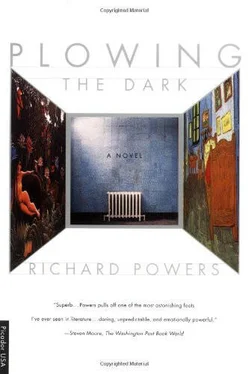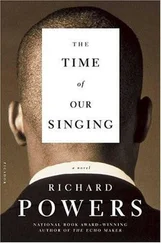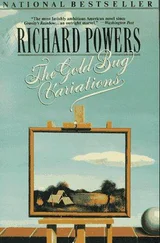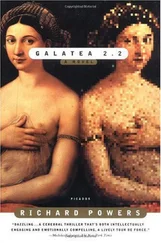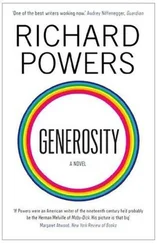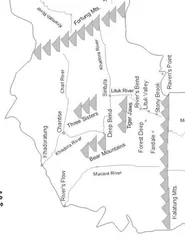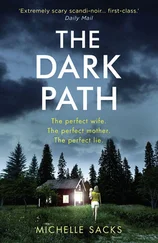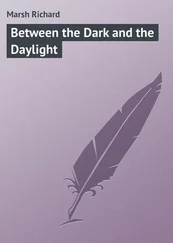Sure, sure. Although I warn you, I cant tell a corbel from a cornice.
And you'll let me litter your little theme park with my personal favorites?
Of course. That's the whole point. Only …?
Go ahead. Say what you were going to say. Only?
She winced. Only… we might want to work from some more recent prints.
Ebesen held the grubby book to his chest for an awful moment. You want me, you get my anthology.
I'm sure we can find an out-of-the-way bush to stick you both under.
So Design's senior derelict led Adie down the overgrown path of Western art. Ebesen muttered to himself while he worked, reciting stray facts and vesper-captions that kept him to the task at hand. She listened as inconspicuously as she could, from across the cubicle, reacquainting herself with all his old, exhausted favorites from scratch. From another's eye.
The man pattered on everything from Paleolithic fertility figures to late-day silk-screened sex sirens. On New Britain, he told her, people believed that humans came to life when the gods dribbled blood on drawings of them.
Or: Picasso thought he'd invented camouflage. And by free association: You know how the Dutch kept the Night Watch out of the hands of the Nazis? They hid it underground, in the Limburg marl grottos.
He'd hold two prints up for her, side by side. Comic in their contrast: Watteau and El Greco. Art has only two obsessions. Denial of death and preoccupation with it. Real achievement depends on either utter indifference or utter terror.
Genuflecting in front of the Ghent Altarpiece, he'd say, Do you know why Mary's hand towel is dirty? The angel took her by surprise, at her prayers. No time to tidy up for the guests. Know why the Annunciation script is upside down? God's dictating, from above…
Karl, Karl. Where on earth do you come up with these things?
She asked his opinion about the eighties international superstars, the market where art now lived. Ebesen just shrugged. His knowledge ended abruptly in the year that Adie's SoHo show had opened.
It passed for friendship in the low fluorescent light, Ebesen's halting glosses, his overture of closeness. And Adie kept her end of the bargain. She cleared herself a workspace in the room that Ebesen shared with Michael Vulgamott. The bagman and the architect had already used their Cavern tool kit to simulate a skeletal bungalow. The viewer could wand through this interior, not just along predetermined paths, but in any direction she cared to explore. Their simulated rooms occupied real volume. Although little more than hasty polygon fills with a dash of surface texture, their interiors held together from any angle. Walls blocked access and doors allowed it. Light streamed through windows from a consistent source. Stairs led up and down. Opposite views supplied each other's complements.
Proof of concept, Vulgamott said. Enough to show how the Cavern can bust open spatial visualization. But just a five-finger exercise. A mock-up for the real tool.
Their idea was to assemble a chest of architectural primitives: three-dimensional icons, universal building blocks for creating countless further rooms. They imagined a visual catalogue of prefab parts, designed once, reused forever — the full Vitruvian library of any building component that imagination might require. Each solid piece had to be deformable along any axis. When Adie joined them, Ebesen had already been working on the Ionic capital for weeks.
We figured we'd start with your more high-demand items, he
explained.
Doric was done. Abacus and echinus each bore resizable handles that one could click and drag to shrink or swell the capital. The moldings below adjusted accordingly, while the necking and flutes stretched to fit snugly onto any column underneath them. The Ionic model improved upon this basic unit, upping the number of flutes, changing the echinus to egg and dart, and adding adjustable volutes.
Ebesen worked the stone meticulously, testing on a flat-screen monitor. He carved, examined, jimmied, and carved again. The tedious scut work fell as far below design as design fell below the skills of the man who, Adie suspected, could freehand any object in creation.
Vulgamott fussed at a nearby screen, perfecting his own pier and shaft. Nobody here is exactly looking forward to Corinthian. Adjustable acanthus leaves. It's going to be a bloody nightmare.
The tool-kit language took ordinary architectural descriptions and parsed them into tiny aesthetic machines. Someday — with luck, before the hour that TeraSys set for a final Cavern rollout — a goggled architect would be able to stand inside this wraparound drafting table and, by clicking, cutting, and pasting in the empty air, produce a ghostly scale-model Parthenon, on the fly. The designer, immersed in a virtual design environment: Vulgamott christened the idea V–CAD. It had a certain recursive beauty, using a chamber of the Cavern itself to build more stately chambers…
So use me already, she told them. Tell me what to work on.
How would you like to be the greatest expert on triglyphs and metopes north of the Bay Area? Michael Vulgamott asked. No experience necessary.
He spoke with a perpetual mope, that burlesque of depression that could only be depression-induced. Even expressions of appreciation sounded like a dental complaint. She slaved over bits of frieze and pediment that she felt sure would please the man. But when he came and stood over her shoulder to monitor her monitor, he could manage no more than a whimper. He'd start to object, and then — objecting to his own objections — trip himself up before he could get back to his sentence's line of scrimmage.
What? she said. Tell me. What'd I do wrong?
It isnt you, doll. He'd turn his back and throw one operatic hand up in the air. It's humanity at large. A persistent source of stress to me.
Michael, Michael, Michael. It's like being back in the Union Square subway station, talking to you. Where d you grow up, anyway?
Hattiesburg, Mississippi. Who wants to know?
Vulgamott nagged at Adie. She couldn't read him. Is he being flip? she finally had to ask Karl one night. Or is he just permanently testy? Adie wasn't sure she could always tell the difference in Karl himself.
Who, Vulgate? The man is holding on by his fingernails for the moment of worldwide redemption. He wants to make the Cavern into a giant ark. He's in a race against the clock to save everything of worth that has ever existed from the flood. It's a thankless business, and the odds are, shall we say, not in his favor.
It was, for Adie, the ideal apprenticeship: time-sharing between her jungle, strewn with its snippets from the West's crumbling museum, and this growing warehouse of Lego blocks, Michael Vulgamott's windbreak against the coming long night. She moved freely between the adjacent countries. Her knowledge of architecture had never extended beyond the obligatory chapter in the survey texts. Now, viewing the trade from the crypt up, she made the connection. Buildings were art's skin, the pictures we lived in. They were many-planed concoctions of color, line, and shape, paintings that had to stand up to the rain. The simplest self-supporting structure involved as many aesthetic decisions as a midsized Titian. A temple's texture and light changed with the season, the hour, the thousand-and-one viewing angles. Frozen music, yes. But also thawed paint: harmony and radiance made whole by an accountability to engineering.
She loved the idea: programming the programmable room to house its own model progeny. Even more perfect were those two models of male strangeness, her supervisors in architecture. For Michael's high-strung perfectionism, she felt increasing respect. Toward her surly bagman, she developed something like a maternal impulse. Proprietary zeal. Finder's pride. The curator's interest in the wrongly discarded.
Читать дальше
